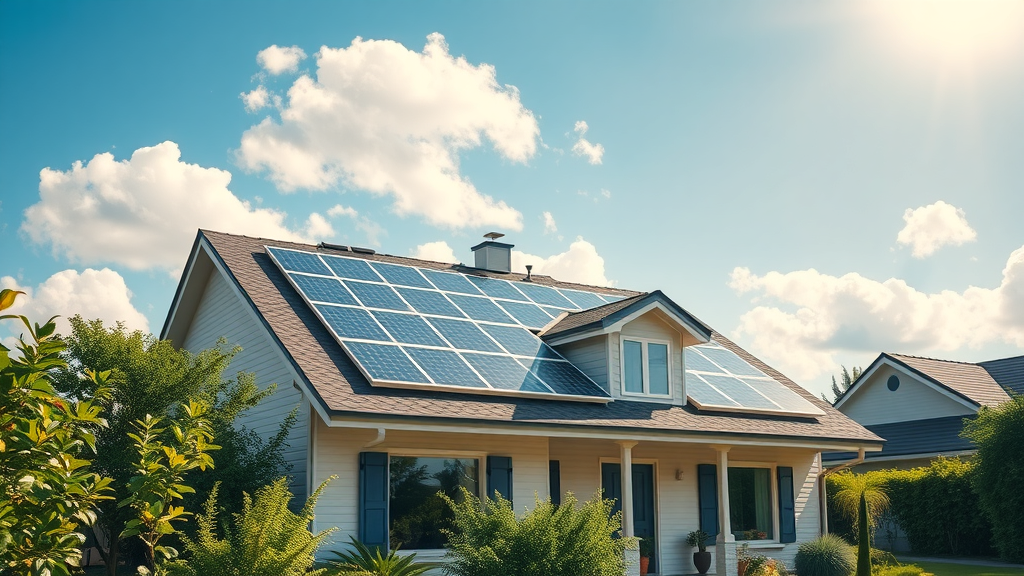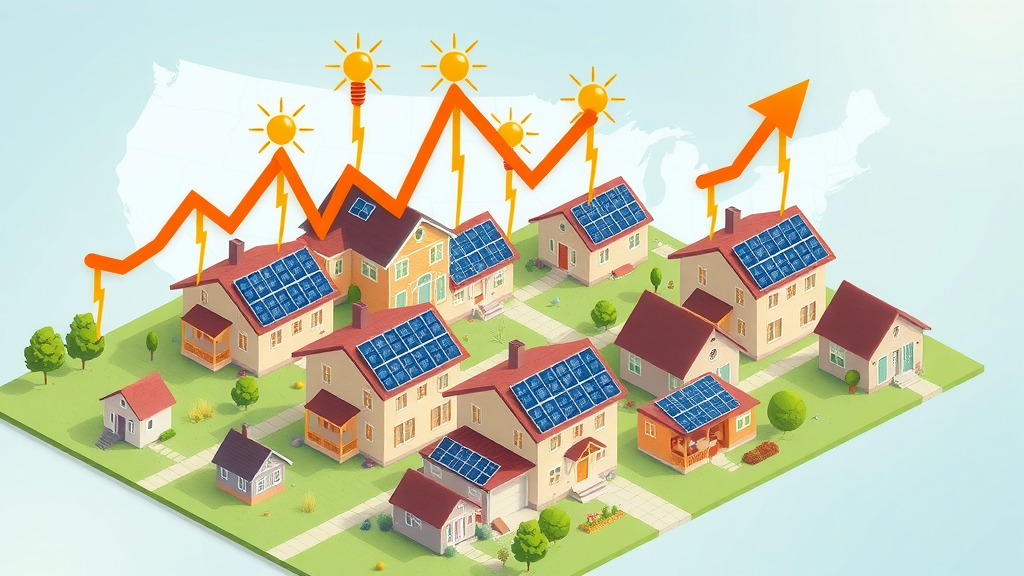Did you know that switching to solar energy for homes can cut annual electricity bills by more than 50%? As energy costs soar, homeowners across the nation are seizing the opportunity to embrace clean, renewable energy—unlocking savings, boosting property value, and future-proofing their lifestyle. Read on to discover how solar power is transforming home energy, the steps to go solar, and exactly how much you can save long-term. If you’re ready to take control of your energy costs and join the solar revolution, this comprehensive guide is for you.

Staggering Growth: Why Solar Energy for Homes is Revolutionizing Cost Savings
Understanding the Rapid Adoption of Solar Panels and Solar Energy
In recent years, the adoption of solar energy for homes has reached unprecedented heights. More than 3 million households in the United States now generate their own electricity from solar panels—a staggering leap that demonstrates both the affordability and accessibility of today’s solar technology.
"Over 3 million households in the US now generate their own electricity from solar panels, cutting annual electricity bills by more than 50% on average."solar power solar panels

How Solar Energy for Homes Works: A Comprehensive Guide to Solar Systems
From Sunlight to Power: Demystifying Solar Panels and Solar Power
The process of capturing solar energy for homes is less mysterious than you might think. It starts when sunlight hits the solar panels mounted on your roof. These panels absorb the sun's rays and convert them into direct current (DC) electricity . However, household appliances use alternating current (AC), so an inverter is used to switch the DC power into usable AC energy, seamlessly powering your home.
This solar energy system operates smoothly and efficiently; when your energy needs are low or solar production is high, excess solar energy can be stored in batteries or sent back to the utility grid—a process often facilitated through net metering. By generating your own clean energy, you’re not only reducing dependency on fossil fuels but also enjoying predictable, lower costs on your electricity bill.
- Solar panels absorb sunlight
- DC power converted via inverter
- Solar energy powers your home
- Excess solar power can be stored or sent to the grid

Types of Solar Panels for Homes: Choosing the Right Energy Source
Choosing the right energy source for your home's solar power system is critical for maximizing efficiency and savings. There are three main types of solar panels commonly used in residential solar systems : monocrystalline, polycrystalline, and thin-film panels. Each type has unique advantages and trade-offs regarding efficiency, cost, and durability . Monocrystalline panels are renowned for their high efficiency and long lifespan, while polycrystalline panels offer a cost-effective balance. Thin-film panels, lightweight and flexible, are ideal for unconventional roof lines or lighter installations.
| Type | Efficiency | Average Cost | Durability/Lifespan |
|---|---|---|---|
| Monocrystalline | High (18–22%) | $$$ | 25–30 years |
| Polycrystalline | Moderate (15–17%) | $$ | 20–25 years |
| Thin-film | Lower (10–13%) | $ | 10–20 years |
Benefits of Solar Energy for Homes: More Than Just Slashing Your Electricity Bill
Top Benefits of Installing Solar Panels and Solar Energy Solutions
While the most obvious advantage of solar energy for homes is a dramatically reduced electricity bill, the benefits extend far beyond just financial savings. Solar panels provide a clean, renewable energy source that brings energy independence and a reduced carbon footprint. With a solar energy system, you can increase your home’s value and leverage government incentives, rebates, and tax credits—accelerating your payback timeline.
Additionally, reliable net metering and performance-based incentives mean that you can monetize excess solar energy sent back to the grid. This comprehensive set of benefits redefines what it means to own your home’s energy future.
- Significant Reductions on your electricity bill
- Reliable, clean renewable energy
- Potential increase in home value
- Solar system incentives and rebates
"Switching to solar energy for homes is the most impactful way to embrace renewable energy and achieve substantial financial savings."

Step-by-Step Process for Installing Solar Energy for Homes
Site Assessment and Choosing the Best Solar Panels
Your journey to installing solar panels begins with a professional site assessment . A solar installer will evaluate your roof’s orientation, shading, and space to determine the ideal location and type of solar panels . Factors such as roof age, material, and local weather patterns are also considered, ensuring your solar power investment is optimized for maximum sunlight capture.

Understanding Solar System Sizing and Installation
Proper system size calculation is essential for meeting your household’s energy needs. Installers use your historical electricity usage to design a solar system that can reliably power your home year-round. They’ll factor in the number of panels, optimal inverter size, and even recommend battery storage if you’re interested in extra backup.
Installing solar is a coordinated effort: after site evaluation and system design, the installation team mounts the solar panels, connects the inverter, and integrates the system with your home energy grid. The process is minimally invasive, typically completed in a few days, and culminates in a city inspection before flipping the switch.
Solar Panel Installation Timeline: What Homeowners Can Expect
The installation timeline can range from several weeks to a couple of months depending on local permitting and utility approval. Generally, it includes:
- Site Assessment and Design (1–2 weeks)
- Permitting and Approval (2–4 weeks)
- Solar Panel Installation (1–3 days)
- Inspection and Grid Connection (1–2 weeks)
Most homeowners find that the brief installation period is a small price to pay for decades of clean energy and cost savings. Many reputable installers also provide progress updates and handle the paperwork, making the process hassle-free.
Solar Energy for Homes: Calculating Costs, Savings, and Return on Investment
Factors Impacting the Cost of Solar Panels and Solar System Components
Solar panel pricing has experienced sharp declines over the last decade, but the total installation cost can vary based on system size, location, equipment brand, and energy goals. Larger homes or families with higher energy usage will need more panels; meanwhile, choices such as opting for battery storage or high-efficiency panels will also influence cost.
Other factors include local labor rates, roof type, and permitting fees. Smart financing options—like solar leases or purchase agreements—can reduce upfront expenses. Don’t forget the impact of tax credits and state incentives, which can slash costs by up to 30% or more. Your installer will break down a clear proposal with line-item estimates and projected payback periods.

How Much Can You Save by Switching to Solar Energy?
Depending on your state, utility rates, and solar incentives, average homeowners who switch to solar energy for homes can see annual savings of $700–$2,500 or more. Over the lifetime of a solar energy system, this adds up to $18,000–$40,000 in total savings . The greater your household’s consumption and the higher your local electricity costs, the faster your investment breaks even.
Net metering , time-of-use rates, and solar renewable energy credits (SRECs) further improve your payback. A typical system pays for itself in just 6 to 10 years and continues to generate free power for 15–25 more. If you finance your system, your monthly loan payment may even be less than your old electric bill.
| State | Avg. System Cost After Incentives | Avg. Incentives & Tax Credits | Payback Period | Estimated 20-Year Savings |
|---|---|---|---|---|
| California | $12,800 | $4,000–$5,000 | 5–7 years | $36,000 |
| Texas | $13,500 | $3,000–$4,800 | 7–10 years | $32,000 |
| Oregon | $11,400 | $5,000–$6,200 | 6–8 years | $26,000 |
| Pennsylvania | $13,000 | $2,800–$4,500 | 8–11 years | $21,000 |
Financial Incentives, Rebates, and Renewable Energy Credits for Homeowners
Governments and utilities at the federal, state, and even municipal levels make solar energy for homes more affordable than ever. The federal solar tax credit offers a 30% reduction on total system cost, while many states add incentives such as rebates or property tax exemptions. Additional savings come from performance-based SRECs and direct cash payments from utilities for excess solar energy sent to the grid.
Explore all programs available in your area—and remember, a certified solar installer will help you identify and apply for every savings opportunity. This ensures you get the maximum return and accelerate your solar system’s payback period.
Key Considerations When Adopting Solar Energy for Homes
Maintenance Tips for Solar Panels and Solar System Longevity
One of the greatest perks of solar panels is low maintenance. With no moving parts, a quick visual inspection and occasional cleaning are all that’s needed to keep panels operating at peak efficiency. Most systems are warrantied for 20–25 years, and reputable installers handle repairs or diagnostics should an issue arise.
To maximize your energy yield, keep panels free of debris and check for potential shade growth from nearby trees. Annual professional check-ups are inexpensive and extend your solar system’s lifespan, delivering reliable clean energy to your home year-round.

Evaluating Solar Power as a Reliable Energy Source All Year Round
Many homeowners wonder if solar energy for homes can deliver dependable power even on cloudy days or in the winter. Thanks to technological advances, modern solar panels are more efficient than ever, producing energy even in low-light conditions.
Energy storage solutions, combined with smart inverters, enable homeowners to store excess solar energy and offset days with minimal sunshine. In states with net metering, you can earn credits for surplus energy during sunny months and redeem them when production drops, maintaining consistent power across all four seasons.
Common Myths vs. Facts About Solar Energy and Solar Panels
Despite overwhelming evidence, several myths about solar energy for homes still persist. For example, some believe that solar only works in sunny climates or that maintenance is complex and expensive. The facts: solar panels are highly durable, require minimal care, and function efficiently even in cooler states.
Myths about high installation costs are also outdated; with tax credits, rebates, and zero-down financing, most homeowners pay little upfront. Modern warranties also guard against performance issues, and today’s data-driven monitoring systems make it easy to track your energy output. Don’t be misled—let the facts guide your decision!

People Also Ask: Is Solar Power for Your Home Worth It?
Weighing the Return on Investment and Payback Timeline
Evaluating if solar energy for homes is “worth it” boils down to crunching the numbers: system cost versus lifetime savings. With strong incentives, rapidly falling prices, and ever-rising electricity costs, most homeowners see returns of 10–15% per year—outpacing many other investments.
The typical payback timeline is under 10 years, with 15–20 years of free electricity thereafter. By factoring in tax credits , net metering credits, and rising utility rates, choosing to install solar panels consistently delivers a strong return, making solar one of the smartest home investments available today.
People Also Ask: How Much Solar Power is Needed to Power a Home?
Proper Sizing of Solar Panels and Solar Systems
The amount of solar power needed depends on your household’s energy consumption, geographic location, and roof size. Installers analyze your last 12 months’ of utility bills to determine your average electricity usage, typically measured in kilowatt-hours (kWh).
Most U.S. homes require between a 6 kW to 10 kW system for full coverage, translating to 16–28 premium solar panels. Factors such as home energy efficiency and the usage of energy-intensive appliances can influence system size . Custom proposals ensure you get a solution tailored to your needs, delivering optimal performance and savings.
People Also Ask: Does the State of Oregon Pay for Solar Panels?
Oregon Solar Incentives, Rebates, and Programs
The state of Oregon is a leader in promoting solar energy for homes through attractive incentives. In addition to the federal tax credit , Oregon homeowners are eligible for the Oregon Solar + Storage Rebate Program, which typically covers between $2,500–$5,000 of system costs. Many local utilities offer additional rebates or performance-based incentives for each kilowatt-hour produced.
As a result, solar installation in Oregon is highly affordable, and payback periods are among the shortest in the nation. Check state program websites or consult an installer to maximize your solar benefits.
People Also Ask: Does PA Have a Free Solar Program?
An Inside Look at Pennsylvania’s Solar Energy Initiatives
While Pennsylvania does not currently offer a “free solar program,” the state supports solar energy for homes through net metering, SREC markets, and low-interest solar loans. Local utilities frequently provide cash rebates or special financing, making going solar accessible with low upfront costs.
Some installers advertise “no-cost solar” through solar leases or power purchase agreements (PPAs). With these, you pay only for the electricity produced by your system—typically at a lower rate than the utility—and avoid all installation costs. Be sure to compare offers and read contracts carefully to pick the financing options best suited to your goals.
Frequently Asked Questions about Solar Energy for Homes
-
How long do solar panels last on a typical solar system?
Most residential solar panels come with a 25-year power output warranty, and many last even longer. Inverters may require replacement after 10–15 years, but the panels themselves deliver decades of reliable energy. -
What are the maintenance requirements for solar energy?
Solar panels require minimal maintenance—usually a quick cleaning (twice a year) to remove dust or debris. Annual professional inspections can help maintain peak efficiency, but no routine mechanical work is needed. -
Can I go completely off-grid with solar power?
Yes, it’s possible by installing both a solar panel system and battery storage. However, most homeowners remain grid-connected for backup power and to maximize savings through net metering.
What Every Homeowner Must Know about Solar Energy for Homes
Practical Tips for Maximizing Solar System Efficiency and Savings
Get the most out of your solar energy system by following smart practices: keep panels clean, monitor energy production via your system’s app, and trim nearby trees to prevent shade. Consider pairing solar panels with home energy-efficient upgrades—like LED lighting or smart thermostats—to further reduce consumption.
Review your electricity bill and data from your monitoring system regularly to track your savings and catch any potential performance drops early. Most importantly, take advantage of utility and state incentive programs to ensure your solar power investment delivers the best value possible.
Action Steps for Embracing Solar Energy for Homes and Cutting Costs
Steps to Get Started With Solar Panels and Renewable Energy Today
- Evaluate your roof’s solar potential
- Get personalized solar panel quotes
- Investigate state and local incentives
- Partner with a certified solar installer
- Monitor your solar power production
Each step ensures your solar journey is smooth and that you maximize every available benefit. Studies confirm that the sooner you install solar panels, the more you’ll save—making now the best time to start.
Make the Switch: Unlock Savings With Solar Energy for Homes
Ready to Reduce Your Electricity Bill? Explore Your Solar Energy Options Now
Take action today: Reach out to local installers, compare solar options, and see how much you could save year after year with solar energy for homes . Unlock the financial and environmental benefits—your energy-efficient, budget-friendly future starts now!
Conclusion: Start your solar journey by evaluating your home's potential, selecting the right system, and seizing available incentives—so you can save big and power your future sustainably!
Exploring the benefits of solar energy for homes can provide valuable insights into cost savings, environmental impact, and energy independence. The U.S. Department of Energy’s article, “Benefits of Residential Solar Electricity” , outlines key advantages such as reduced utility bills, increased home value, and the environmental benefits of using renewable energy. Additionally, Zillow’s “A Homeowner’s Guide to Going Solar” offers practical advice on incentives, financing options, and tips for selecting reputable solar installers. If you’re serious about transitioning to solar energy, these resources will equip you with the knowledge to make informed decisions and maximize your investment.
 Add Row
Add Row  Add
Add 




Write A Comment